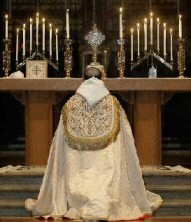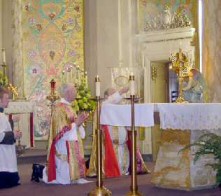

|
|
| Musical Musings: Miscellaneous |
The Sweet Smell of CatholicismThis article appeared in the May-June 1995 edition of Catholic Heritage magazine, formerly published by Our Sunday Visitor, Inc. The magazine is no longer being published. Eucharistic devotions keep the assembly of believers together for holy moments of worship.
Although from the Middle Ages to the reforms of the Second Vatican Council many Catholics tended to think of the Eucharistic as a sacred object — consecrated bread — the word refers to the entire combination of rituals that hold the assembly of believers together for worship. The Eucharist, therefore, is not only a holy bread and a holy cup, it is a holy moment — a saving action. It has been the faith of Catholics from earliest times that Jesus Christ is present during the Eucharistic ritual; those who share the bread and cup with one another become one with Christ and one with one another because it is the one Christ whom they share. According to the post-conciliar ritual and instruction regarding Holy Communion and the Worship of the Eucharistic Mystery Outside of Mass (1973), The Eucharistic sacrifice is the source and culmination of the whole Christian life ... The cult of Eucharistic devotion should be in harmony with the sacred liturgy in some sense, take their origin from the liturgy, and lead people back to the liturgy. (#79) Four forms of Eucharistic devotions derive from reserving the sacrament — exposition, Benediction, processions and congresses. American Catholics of today often treasure memories of one or more of these devotional practices as they knew them in their youth or childhood. All of the Eucharistic devotions known in America stemmed from European Catholicism, most having emerged during the Middle Ages. By the year 1000, the consecrated bread was considered too holy to be touched by the laity, and it was placed on the tongue. Christ's divinity was so emphasized that the people developed a feeling of unworthiness to partake of the sacrament. This prevented them from receiving Communion, and eventually the Church had to legislate that Communion be received at least once a year, leading to the Church law of the Easter duty in 1215. In the Middle Ages, to see the Eucharist now became more important than to take it and eat. In the 14th century, it was common for people to rush from church to church to see elevations, believing that a glimpse of the Blessed Sacrament would bring good luck or protect them from a sudden death. Eucharistic processions became very popular, including those held for viaticum (Communion given to those in danger of death). After the establishment of the feast of Corpus Christi in 1264, these processions became known in almost every country of Europe. The Blessed Sacrament was carried in a splendid procession through town after Mass. During the later Middle Ages, the procession developed into splendid pageants of devotion and honor to the Blessed Sacrament. These were still held, often with the ancient splendor, in many parts of Europe until the early part of this century. The liturgical procession was accompanied by sovereigns and heads of state, members of trade and craft guilds, and honor guards from the military. Houses along the route were decorated, and especially in Latin countries the streets were often covered with carpets of grass and flowers, often wrought in beautiful designs. Bands played sacred hymns, church bells pealed and the people knelt in front of their homes to adore the Eucharistic Lord. Especially appealing was the adaptation of the ancient usage of "stations," or stops, which were made along the route where the Blessed Sacrament was put on an altar table and a passage of the Gospel was sung, followed by hymns and prayers for God's blessing on the town, the people and the harvest. A Eucharistic Benediction concluded each station. 
The first Eucharistic Congress was held in Lille, France, in 1873, and it was followed by several local, national and international congresses. This modern demonstration of faith in the Real Presence is simply a large public gathering where clergy and laity assemble in one city for the purpose of rendering homage to the Holy Eucharist by public adoration and general communions, and the discussion of means to increase devotion to Our Lord in the Blessed Sacrament. This custom continues today. The international Eucharistic Congress held at Munich in 1960 marked the merging of this devotion with the liturgical movement, and since then the celebration of the Eucharist has been the center of these congresses. According to the current rite, the Blessed Sacrament is never exposed just for Benediction, but Benediction is the conclusion of Eucharistic worship (exposition), which flows, fittingly, from the Mass. The beautiful ceremony of Benediction is where the Sacerd Host is exposed in an ostentorium (or "monstrance") and incensed during the singing of hymns. After the chanting of a versicle and prayer, the priest makes the Sign of the Cross over the people with the monstrance, giving a blessing in silence, although the sanctuary bell is often rung. The Blessed Sacrament was commonly carried in processions on the feast of Corpus Christi in a transparent vessel resembling today's ostentorium. Later on, the continual exposition of the Blessed Sacrament came into vogue, although this was repeatedly condmened by the ritual laws. A sort of revolving tabernacle was devised that could be rotated and opened, permitting a view of the Sacred Host. In England and France, the custom arose of having evening services in honor of the Blessed Virgin, and at times the Blessed Sacrament was sometimes exposed on the altar. It was natural to give a blessing with the Sacred Host, as had been previously done after processions. Thus Benedcition developed into its present form. The rite was often used as a conclusion of other services such as vespers, the Stations of the Cross or the devotional meetings of sodalities. The Forty Hours devotion is a comparitively new one, the history of which goes back only a few centuries. It seems to have gradually evolved from the solemn ceremonies of the Blessed Sacrament held each year on the feast of Corpus Christi. Soon the Sacred Host began to be left on the altar for public adoration. This was found to be particularly useful at carnivale, the two days before Lent. In many countries, great excesses were committed at carnival, and the bishops sought to prepare for the penitential season by exposing the Blessed Sacrament solemnly in the churches for forty hours, in memory of the time during which the Sacred Body of Jesus was in the sepulchre. The history of the devotion is difficult to trace exactly, but the custom of having the adoration in various churches on successive Sundays apparently originated at Milan, Italy. It was probably introduced by the Capuchins about 1537, when a severe plague afflicted the city. Saint Anthony Zaccaria, Saint Charles Borromeo and Saint Philip Neri reinforced and spread the devotion, and a number of indulgences were eventually attached to it. Saint John Neumann, bishop of Philadelphia, introduced the devotion into his diocese and made it a diocesan devotion. The Second Plenary Council of Baltimore officially introduced the devotion into all the dioceses of the United States in 1868. Through the centuries, Catholics have always maintained devotion to the Blessed Sacrament. As stated in the Catechism of the Catholic Church, "For in the blessed Eucharist is contained the whole spiritual good of the Church, namely Christ himself, our Pasch." (#1324). Eucharistic FastFasting has traditionally been one of the foremost ways in which Catholics express their desire to share in the sufferings of Christ. Prior to the Second Vatican Council, abstaining from all food and drink (except water) from midnight until the reception of the Eucahrist was mandatory. The fast was substantially mitigated at the end of the pontificate of Pope Pius XII. After the council, the fast was reduced to one hour before the reception of Holy Communion. Even this fast may be reduced to 15 minutes for those who are sick or who must eat before receiving the Eucharist for some important reason. Many of today's adult Catholics recall the days of the stringent Eucharistic fasts, often with a bit of wry humor. Mike Cozzi, of Houston, Texas, said he stayed up so late on Saturdays that he wouldn't have had time to fix breakfast anyway. As a teenager in the late 1950s and early 1960s, he recalls going to early Mass with his dad, and stopping at a local coffee shop after church to have coffee and danish. Dale Rensing, of Fountain Valley, California, recalled that it was his mom's job on Sunday morning to patrol the kids and remind them not to go near the fridge. The family usually went to one of the earliest Masses at Saint Anselm's in Inglewood. As soon as they got home, the kids kept the toaster popping until mom got breakfast on the table. Rensing, who attended the parochial school at Saint Anselm's in the late 1940s and early 1950s, recalls that on really special occasions, such as First Communion, the church always had paper taped over the water fountains. Dale's wife, Pat, grew up in the same parish. She remembers walking to the earliest Mass. Their non-Catholic father liked to cook and rarely attended Mass with the family. Often, on returning home, their dad had made a large breakfast of eggs and fried potatoes, or pancakes. Pat laughingly recalls that no matter how fancy Sunday breakfast was, however, the kids all had to take their daily does of S.S.S. Tonic, a blood-building tonic based on cod-liver oil, mandated by her health-conscious godfather. When asked how the strict Eucharistic fast affected him, Father Jack Broussard, of the Congregation of Saint Basil, said the fast was an impractical law for mission territories where the priests regularly traveled to say three or four Masses, often not finishing until two or three in the afternoon. "Of course we got hungry, but I would only say it was inconvenient, not grueling," said Father Broussard. "It was probably hardest on the older priests; I was young and healthy, so it really didn't bother me too much." Ann Ball writes from Houston TX. |
 The sweet smell of Catholicism — the lingering odor of incense — permeated all Catholic churches until recent times.
The smell was left over from the lavish incensing of the Blessed Sacrament during Benediction.
A consecrated Host was kept locked in the tabernacle, and often the Sacred Host was placed in a golden monstrance and exhibited for all to see and adore.
The sweet smell of Catholicism — the lingering odor of incense — permeated all Catholic churches until recent times.
The smell was left over from the lavish incensing of the Blessed Sacrament during Benediction.
A consecrated Host was kept locked in the tabernacle, and often the Sacred Host was placed in a golden monstrance and exhibited for all to see and adore.